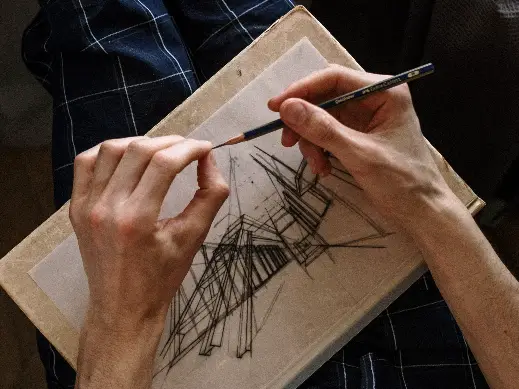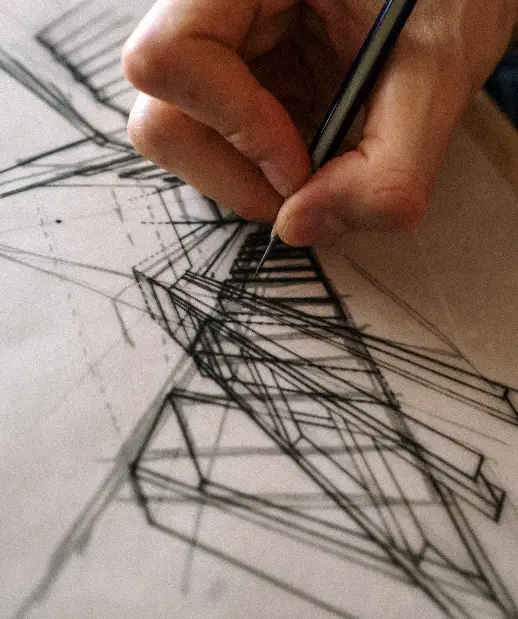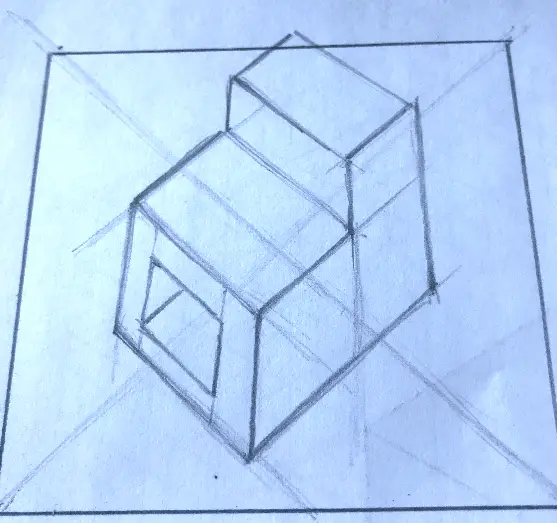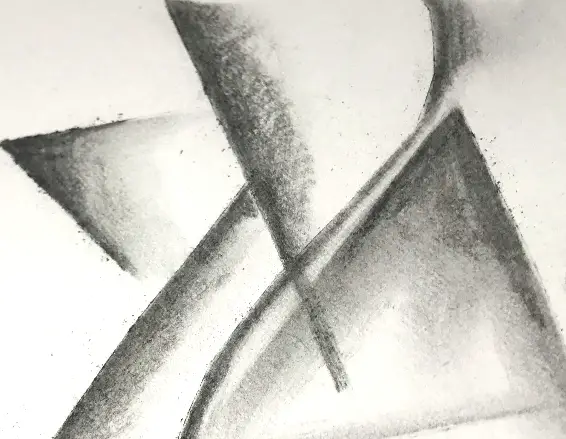Introduction to Geometric Drawing?
You've heard about this before, but it doesn't always apply to mechanical drawing, as you'll soon find out. Geometric drawing for the average artist has everything to do with technical shapes that loosely revolve around basic mathematic principles.
Examples of Basic Drawings
You would be surprised at the simplicity of geometric art since it doesn't require the delicate touch of using freehand skills. Most of the basic drawings that you can create with geometric art are straight lines drawn using an ordinary ruler.
The only catch is to create an image that is composed primarily of lines. These lines can be long or short and often repeat themselves like a mirror to create a complete image such as an animal or a face.
Whatever shape you decide to take on, each line that's s drawn doesn't need to be precisely the same length if you're making a mirror image.
Much like working with children's construction blocks, these form an image using straightforward building block shapes, including triangles, squares, and rectangles.Use this link to access Drawing Courses at Domestika January Sales at Domestika with courses up to 75% off.
Point to Point Drawings
It's true, point to point drawings are precisely what you might be thinking if you guessed those silly dot-to-dot pictures in children's activity books. But is this really what point-to-point drawings mean?
The reality of these drawings involves a series of dots or ‘points' that create a picture that uses a single connected line to connect the dots. With basic drawing, using a point-to-point method is similar to that old song about building a skeleton.
Some artists will use this method to create a skeleton shape using general gauge points to construct a basic point system. The hip bone is connected to the leg bone, and so on.
This speeds up a process that would otherwise take longer to sketch out a shape or figure by hand, so only practical points are used to connect these connection points.
Related Posts:
- Is Perspective Difficult?
- How to Draw a City Street in Perspective
- How to Shade a City Street in Perspective
- How to Draw in 3D
- How to Draw with Perspective
Geometric Line Art
Geometric line art is very similar to point-to-point drawing since you can use spaced points to plot your lines' starting and finishing. What is put in place of freehand drawing is then replaced by geometric shapes instead. So it really does feel more like point-to-point style drawing.
A shape can be composed of individual geometric shapes linked and connected together, forming the picture you want to create.
The exception is that specific shapes can be modified from the basic building blocks, including triangles, squares, and rectangles. These can be stretched and warped as you wish, so the final form has a precise geometric shape left behind.
To create the illusion of curved lines, edges and angles have individual connection points within a three to four-point connection creating additional connecting points to make them five or six-point shapes. They still appear as an essential building block with added angles to make them fit further into your geometric drawing.
Please look at this drawing and sketching video course I have created. Use this link.
Drawing Geometric Shapes:
Not all geometric shapes are simple block patterns and will have individual block names that can be used in your geometric drawing pattern. Some of these you already know, while others are customized shapes.
These complex shapes aren't always the best to include in your drawing, but with a bit of imagination, they'll find their way into fitting into your image if you use them artistically.
Isometric Cube
The isometric cube is simply a square drawn in 3D so you can see a three-quarter view of the cube itself. It will always have three sides showing. As if you are looking at a square block from above or below.
Each of the lines will be equal and angled typically at 30 degrees to each other just for perspective reasons. These cubes can be stacked onto each other to create any number of blocky images, just like you would see in Minecraft.
Alternatively, Isometric cubes must follow a two-point perspective when stacked together, so they all fall in line with a perspective drawing.
This means that it includes a horizon line and two separate vanishing points angles around 30 degrees to make your blocky image appear more natural.
Flat Circle
Drawing a flat circle within a geometric drawing uses the same principle to draw in perspective. Using a predetermined horizon on your paper, you'll need to draw a flat square onto your landscape. The edges of the square aren't 3D at this point.
All you're doing is laying down a basic square shape according to a vanishing point and the equal sides of your square within the picture.
You will then apply your circle inside this square based on the shape of the square. Your circle will appear more oval-shaped when it fits within this dimensional version of a flattened square.
After this, you now have a flat circle that can be built into any required shape afterward.
Squares
No matter what you want to call this shape, a square can be a cube, block, dice, or box. This basic building block will be widespread in geometric shapes and will also follow a dimensional image. Since a square has 4 equal sides, placing this onto a plat surface is simple enough, but the rules change right away when you apply it into a perspective drawing.
You will always need to plot out your horizon and what angle your square is seen from.
This allows a square to take on a cube, block, box, or dice shape. Adding more squares onto or connected to your square is only a matter of stacking the same shape onto each piece, following the same rules as above.
Triangle
A triangle has three equal sides no matter what shape you elongate the lines connecting all three connection points. A stretched triangle can instantly create a rectangle on a flat surface when the image is reversed and flipped, making a triangle very universal.
By itself, with equal sides, a triangle becomes a practical shape when making geometric images fit together tighter and have the illusion of being rounded when they're stretched and stacked.
If you're new to geometric drawing, you can't go wrong with using triangle shapes since they will help nearly any pattern or drawing fit together using different sized triangles that all fit together ‘nice and neat.
Semi-circle
Let's call this for what it is, it's a half-circle, and it will require half of a circle that is drawn, right? Not exactly in this case if you decide to make a semi-circle within a perspective drawing.
You'll need to start with a simple square to place your circle into, and after that's complete, you can divide your circle into one half. This takes more time, but at least you'll get the dimensional results you need to make it appear correct.
On a totally flat surface drawing, making a semi-circle is a simple as using a circumference tool to get the right-sized circle and running a line down the center. Depending on the size you need. You can also substitute a circumference for a round cup or the cap from a jar.
Rectangle
All rectangles have four sides, with two of them being longer in length or width and running parallel. Flat rectangles are always easy to draw when they're one-dimensional, but just like a square drawn inside perspective drawing surfaces, you'll need to give this shape matching dimensional angled edges. Rectangles can also be divided into elongated triangles very quickly.
You simply draw a line down the left side of one leading edge to the right side of the lower edge. This changes the look of a rectangle and helps disguise it further within a geometric drawing.
Parallelogram
To most of us who aren't big on mathematical equations, a parallelogram looks like a rectangle leaning off to one side. The actual definition of how a parallelogram works will include 2 pairs of parallel opposite sides.
Another way to help define this further is to say it has 2 pairs of equal sides that match and run parallel with opposite sides. So essentially, each bisecting side that is angled to one side matches the other.
No matter after the fact, drawing a parallelogram will be trickier within a perspective drawing unless you draw the shape as it should be seen instead of mistaken for a rectangle seen at a weird angle.
Rhombus
Unlike a diamond shape that will appear in the shape of a kite, a rhombus has four equal sides that are all the same length. A diamond shape has 2 matching sides with an upper and shorter half, while the lower half is longer.
A rhombus is a virtual mirror image of itself when divided in half and quickly becomes a triangle. Even after being divided in half, the triangle itself will have three equal-length sides.
When a line is drawn from one corner to the other inside with an opposing line forming an x within a rhombus, you will have 4 divided triangle shapes. They won't be equal lengths because of this division but won't make your rhombus nonetheless unattractive either.
Trapezium
The trapezium may look similar to a concrete deck anchor but is a shape that is based on a strict set of angles to determine the final shape. The bottom is flat with two adjacent sides that are angled inward at 65 degrees.
The combined degree for both of these sides comes to 180 degrees. The inward sides pointing sides are always half as long as the base tends to be. The remaining portion covering the top is one-quarter larger than the angled sides.
Essentially, your trapezium can be sectioned into two triangle shapes on each end, with a rectangle standing within the middle.
Is Geometry Used in Drawing?
Even if you know this little fact or not, it's widespread that mathematics and geometry are used in drawing all the time. It's not a matter of crunching the numbers like you see in bookkeeping but is more or less a silent partner for making simple calculations.
Often, these calculations are used to establish the scale and relative size of objects or body proportions. And though these are often referred to as drawing formulas, they use geometry and math.
Figure Drawing
The basics of figure drawing rely heavily on proportional examples of how a skeleton and human form are built. Whether you learn that a person's overall height is approximately 7 heads, but this is a rough estimate of actual height.
Proportions are using mathematics and preset calculations to get the correct scale according to established formulas. The actual use of geometrics in figure drawing is simplified using block forms to simulate the human body.
Portrait Drawing
Geometric portraits have become very popular over the years and are give a different look and feel to drawing in general. The human face is broken down into sections that begin to take on a multitude of geometric shapes.
These shapes often follow existing shadow lines, but the real trick is creating a three-dimensional curvature of lines seen all over the face and head.
You don't have to follow specific mathematical rules, but it does make sense to follow curvature lines that turn into angles and complex triangle patterns. This gives more realism as if the image was entirely created from 3D geometric shapes forming a human face.
Basic Still Life
A formula is used for still life that dictates how objects need to be arranged. This has everything to do with proportions and is a visual spacing. You don't want a still life drawing to be a sausage party for some delicate orchid, so proper spacing for your props is essential!
After this, you can use any number of geometric shapes to replace your props. The placement of these props and spacing used will complement the geometric shapes you use.
What is Geometry Used In?
A few other notable trade skills frequently use geometry to create complex shapes and forms. Some artists who have a very clear aptitude for math and mathematic formula will understand how valuable these skills happen to be.
These skills also carry over into traditional schematic art and architecture. Here are three examples that many professionals use geometry to create defined artwork.
Technical Drawing
What used to be called technical drafting or mechanical drawing is now commonly referred to as technical drawing. It's the same thing, and instead of being calculated on paper, these professionals use computer software to get the job done.
The innovation of CAD and AutoCAD eliminated the need to draw technical diagrams on paper. It's also stored and corrected mathematically on a computer, so there are no mistakes that could be made.
Those who did learn the basics of learning technical information and mathematic specifics can appreciate how hard this job really is.
Isometric
This is a specific drawing skill that helps illustrate how objects fit together or can be arranged. It's a simplified version of block-style drawing which uses geometric shapes to provide isometric projections.
These are not created to look three-dimensional but more of a two-dimensional object seen without breaking the 3D perspective. If you've ever played Farmville or other village building smartphone games, this is a perfect example of Isometrics.
Perspective
You already know that perspective drawing uses a simple perspective plane to establish the horizon and vanishing points. Putting geometric shapes into this perspective relies on the same rules to make any shaped geometric object inside three-dimensional spaces appear realistic.
The angle you see these objects all follow the traditional rules and can two vanishing points to make these geometric shapes more defined.
What is Geometric Art Called?
One of the most commonly used expressions that geometric art is called is Geometric Abstraction. If you've ever seen many Picasso paintings that use geometry, he likes to call this Cubism.
In France, they have a word that also describes geometric art and is called Le Neoplasticime. The tulip lovin' Dutch also claims this style, calling it ‘De Stijl' -(The Style) when describing geometric art.
No matter what part of the world you come from, there will always be a different word to describe this type of art . Is it enough to call it abstract? In one sense, the usage of geometric shapes makes art constructed from building blocks look pretty abstract, but there is organized chaos.
The reason it's called abstract is due to the blocky nature of how it appears.
How Many Types of Geometric Drawing Are There?
There are only two types of geometric shapes when it comes to drawing them on paper. The first is a 2D which is your run-of-the-mill flat shape of any kind of geometric shape. Then there is the 3D version which gives a geometric shape more definition and realism. If you have to ask the question as to how many actual geometric shapes there are, the list is pretty exhaustive. Here is a complete list of basic geometric shapes .
What is the Importance of Geometric Drawing?
Geometric drawing is as essential to everyday living as the air is free to breathe! It may seem complicated to get past the ironic and sarcastic notion that geometry is the basic building block of our very society.
Without mechanical drawing, there would be no buildings or structures that would survive very long. Geometry is used to design new products, designs, and machines that we use every day.
Geometric drawing helps us solve problems through age-old engineering skills, using these drawings as blueprints to make them a reality. Geometric drawings are also used to design electronics that make every electronic device work.
Is it wonder why little toddlers are given geometric blocks to play with at such an early age? We use geometric drawing in its simplest form to solve problems more than you think since it's a skill we can all relate to.
To deny the notion as to what is geometric drawing is compared to anything else we take for granted in this world. We cannot live without geometry for the simple reason that we as a species are perpetually moving forward using technology that is part of our ancient past.
The fact that geometric art is commonly used more than it gets credit for is why many artists often forget how essential these skills are.
Create Art With My Favourite Drawing Resources
General Drawing Courses. I like Udemy if you want to develop your knowledge of drawing techniques. Udemy is an excellent choice due to its wide range of creative courses and excellent refund policy. They often have monthly discounts for new customers, which you can check here. Use my link.
Sketching and Collage. Take a look at this sketching resource I have created. Use this link.
Proko. Is one of my favorite teachers who surpasses in the teaching of Anatomy and Figure drawing. Prokos course breaks down the drawing of the human body into easy-to-follow components aiding the beginner to make rapid progress. For this, I really like Proko.
Art Easels. One of my favorite ways to draw is by using a drawing easel, which develops the skill of drawing on a vertical surface. The H frame easel is an excellent vertical way to add variety to the style and type of marks you create when using a drawing board.
To see all of my most up-to-date recommendations, check out this resource I made for you.




